
While spring and summer are known as the top seasons for gardening, you can keep garden beds looking their best even in winter with a few well-chosen plants. Winter interest plants are plants that maintain color, form or other intriguing elements even in winter after other plants fade. In this guide, we’ll cover our top picks for the best plants to grow in the winter garden for lots of color, texture and other delights.
Jump to:
- 24 best plants for a colorful winter garden
- 1. Winterberry (Ilex verticillata)
- 2. Red twig dogwood (Cornus sericea)
- 3. Holly (Ilex aquifolium)
- 4. Paper birch (Betula papyrifera)
- 5. Rowan (Sorbus aucuparia)
- 6. Snowdrops (Galanthus nivalis)
- 7. Winter aconite (Eranthis hyemalis)
- 8. Japanese pieris (Pieris japonica)
- 9. Ornamental brassicas (Brassica oleracea)
- 10. Witch hazel (Hamamelis virginiana)
- 11. Cyclamen (Cyclamen persicum)
- 12. Japanese barberry (Berberis thunbergia)
- 13. Cotoneaster (Cotoneaster apiculatus)
- 14. Beautyberry (Callicarpa americana)
- 15. Rose (Rosa rugosa)
- 16. Winter heath (Erica carnea)
- 17. Pansies and violas (Viola spp.)
- 18. Harry Lauder’s walking stick (Corylus avellana)
- 19. American wintergreen (Gaultheria procumbens)
- 20. Hellebores (Helleborus orientalis)
- 21. Ornamental grasses
- 22. Tibetan cherry (Prunus serrula)
- 23. Coral bells (Heuchera americana)
- 24. Golden willow (Salix alba)
- Frequently asked questions
- Summary
24 best plants for a colorful winter garden
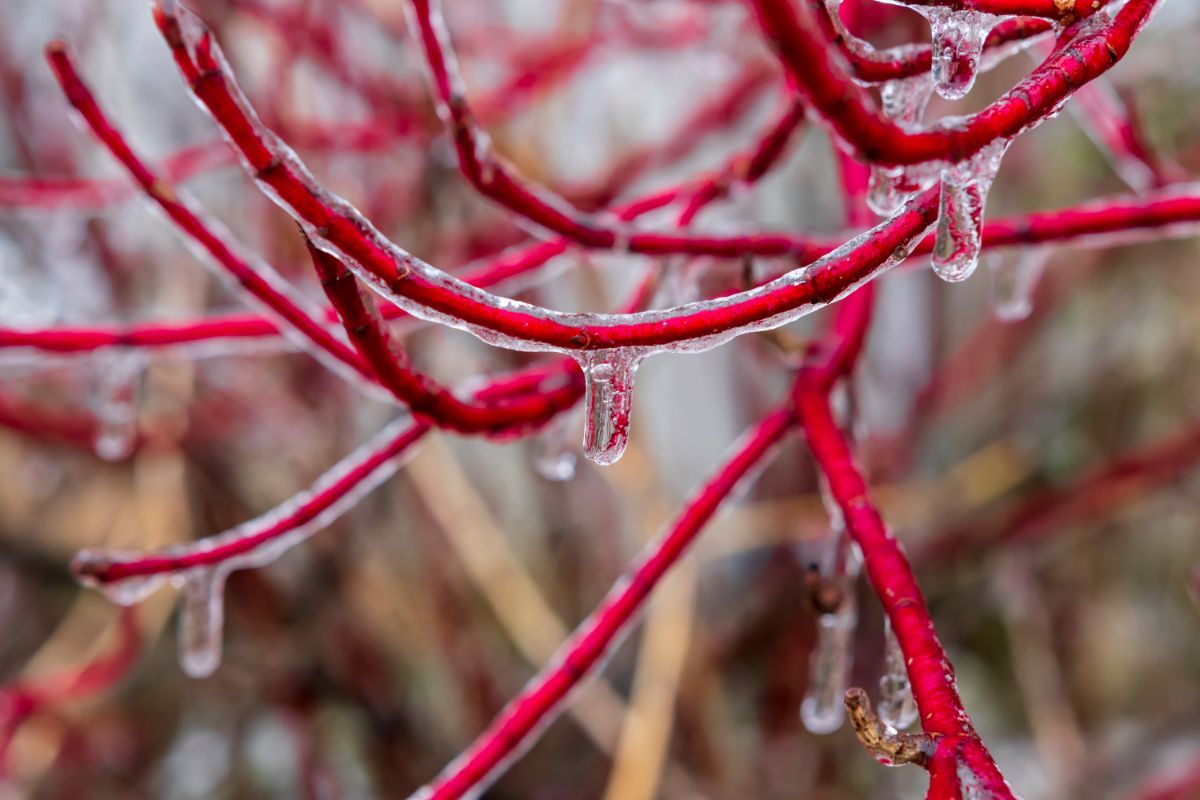
From low-growing ground covers to large specimens, in the following list we’ll cover our favorite winter interest plants. For more variety, we’ve picked out berry-producing specimens for pollinator gardens, edible species and even winter-blooming flowers. So, no matter your gardening interest, you’re sure to find the best winter interest plant for you in this list.
1. Winterberry (Ilex verticillata)
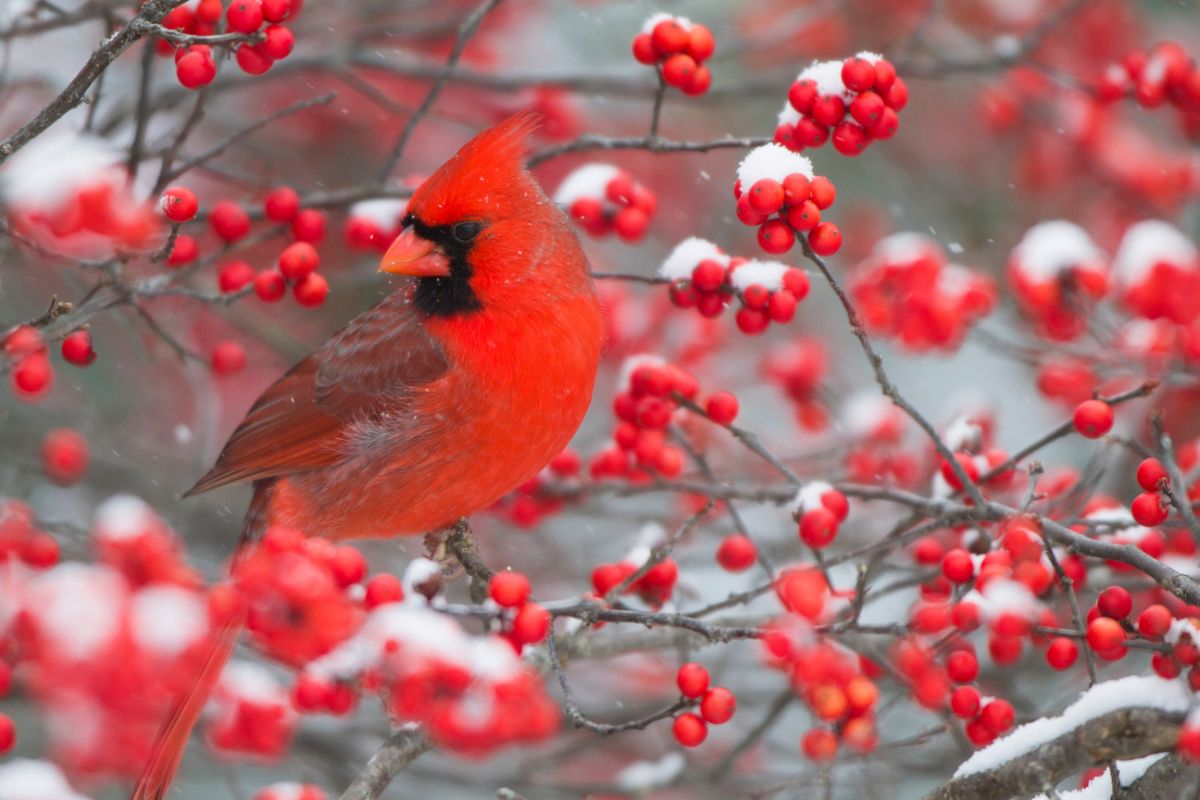
| Plant name: | Winterberry |
| Lighting requirements: | Full sun to part shade |
| Watering requirements: | Moderate to high |
| Growing zone: | Zones 3 to 9 |
| Special features: | Colorful berries; attracts birds |
A species of holly native to North America, winterberry is a deciduous shrub that grows from 10 to 20’ tall. For smaller garden spaces, look for dwarf varieties, which grow to about 3 to 5’ in height when mature.
As its name implies, winterberry sets bright, red fruit late in the season. Highly colored berries last all winter long and are a favorite treat for visiting birds. However, in order to get berries, you will need both a male and female winterberry plant.
2. Red twig dogwood (Cornus sericea)
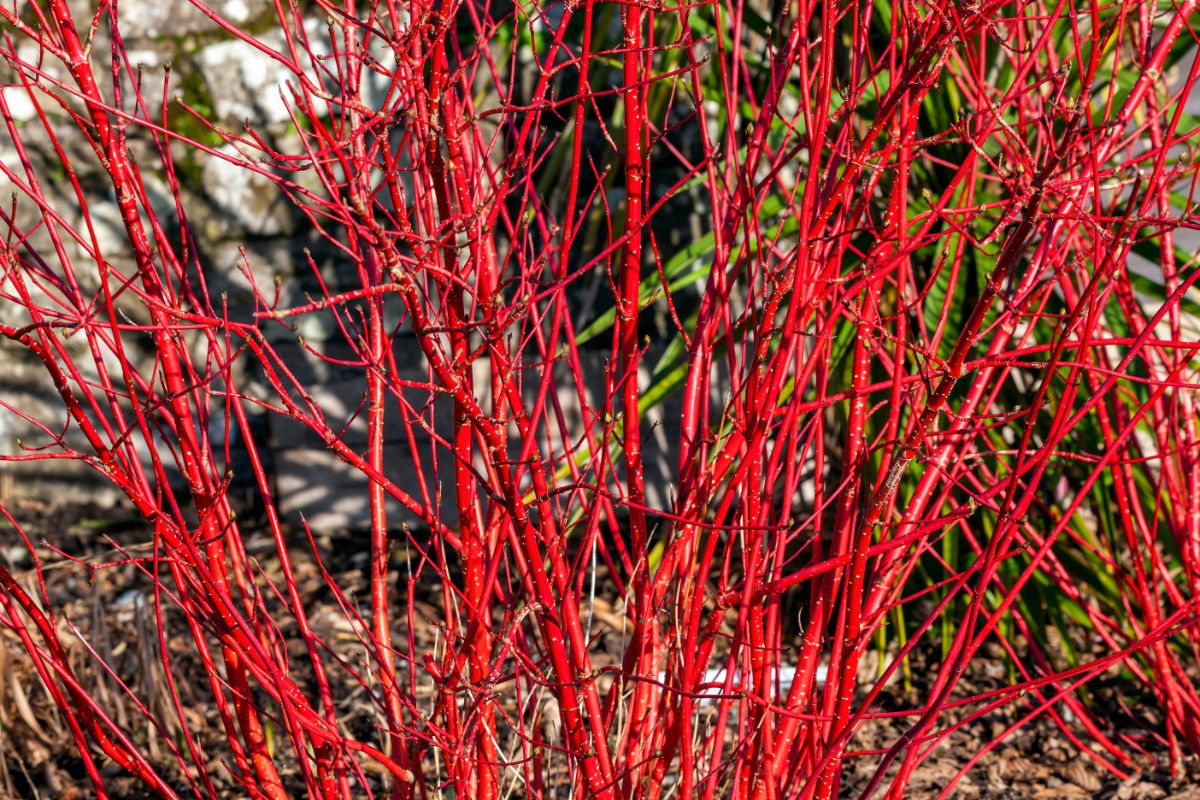
| Plant name: | Red twig dogwood |
| Lighting requirements: | Full sun |
| Watering requirements: | Moderate |
| Growing zone: | Zones 2 to 8 |
| Special features: | Brightly colored branches |
Another vibrant plant for winter beds, red twig dogwood is an interesting shrub in that its color lies in its bright red branches. During spring and summer, this deciduous bush boasts oval leaves and foamy, white flowers, but the true show starts in autumn when leaves fall. Once exposed, the bare branches of this dogwood species are certainly eye catching, lending wonderful structure and sharp lines to landscape designs.
If you like this species, try out yellow twig dogwood (growing zones 3 to 8) too for even more color variety!
3. Holly (Ilex aquifolium)
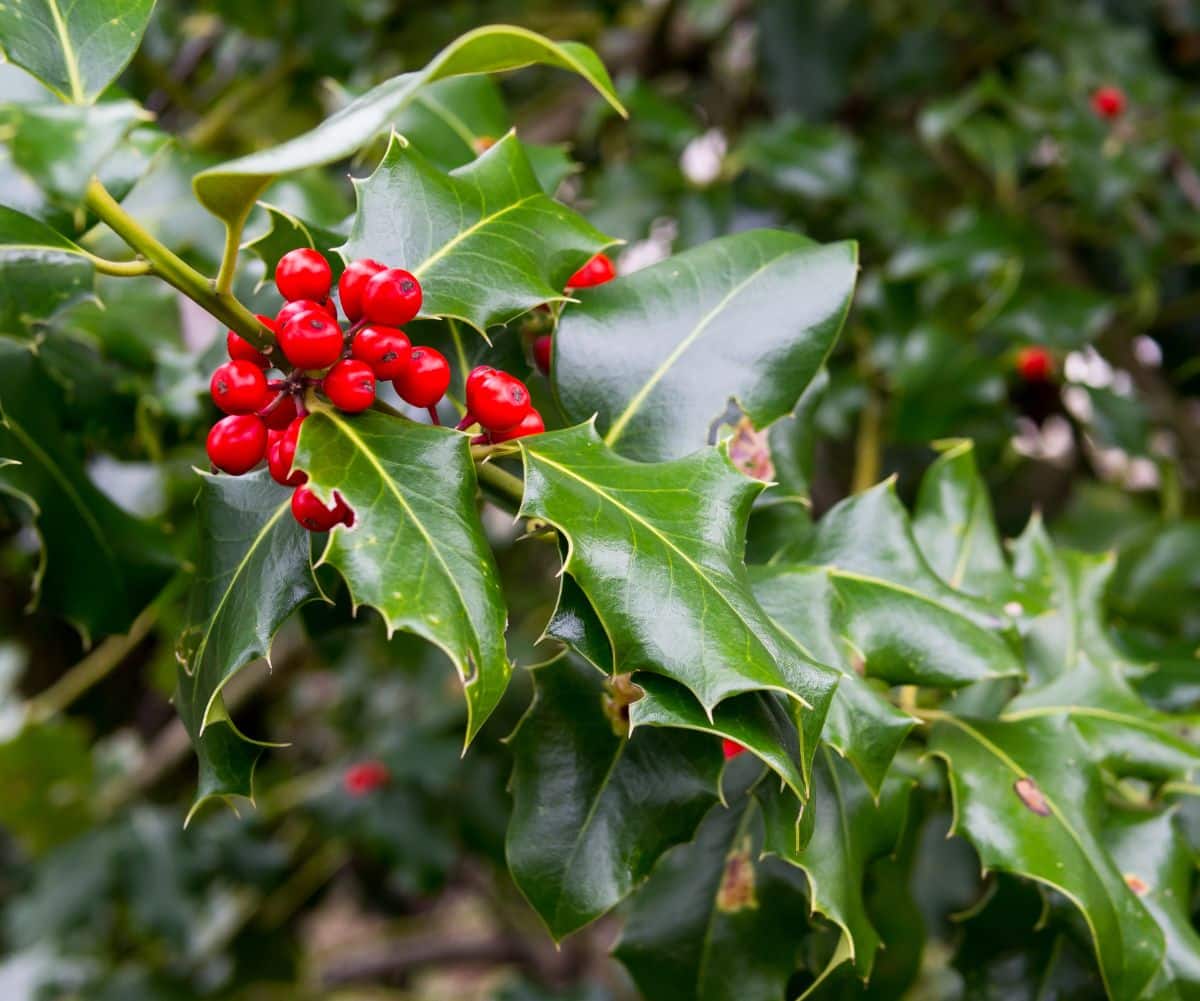
| Plant name: | Holly |
| Lighting requirements: | Full sun to part shade |
| Watering requirements: | Moderate to low |
| Growing zone: | Zones 5 to 9 |
| Special features: | Colorful berries; attracts birds |
Also known as English holly or common holly, this popular bush is a must-have in any winter garden. With its iconic glossy and spiky leaves, holly adds loads of interesting texture to gardens. And, as an evergreen shrub or tree, holly leaves keep their color all winter long.
But holly’s true beauty shows to its fullest when the plant bears red berries in winter. An important food source for wild birds, like cedar waxwings, holly sprigs are also lovely additions to holiday wreaths and ornaments. However, like winterberries, you’ll need to keep both male and female plants to produce berries.
4. Paper birch (Betula papyrifera)

| Plant name: | Paper birch |
| Lighting requirements: | Full sun to part shade |
| Watering requirements: | High |
| Growing zone: | Zones 2 to 7 |
| Special features: | Highly contrasting bark |
Native to North America, paper birch is a short-lived species of birch tree known for its white, papery bark. A relatively fast-growing tree, paper birches reach full maturity at around 70 years of age, but only live about 200 years. Once full grown, paper birches usually reach about 50 to 70’ in height.
Fallen paper birch branches lend themselves well to holiday crafting – such as homemade candleholders and wreaths. Just avoid peeling the papery bark from living trees as this can damage the tree’s nutrient transport system.
5. Rowan (Sorbus aucuparia)
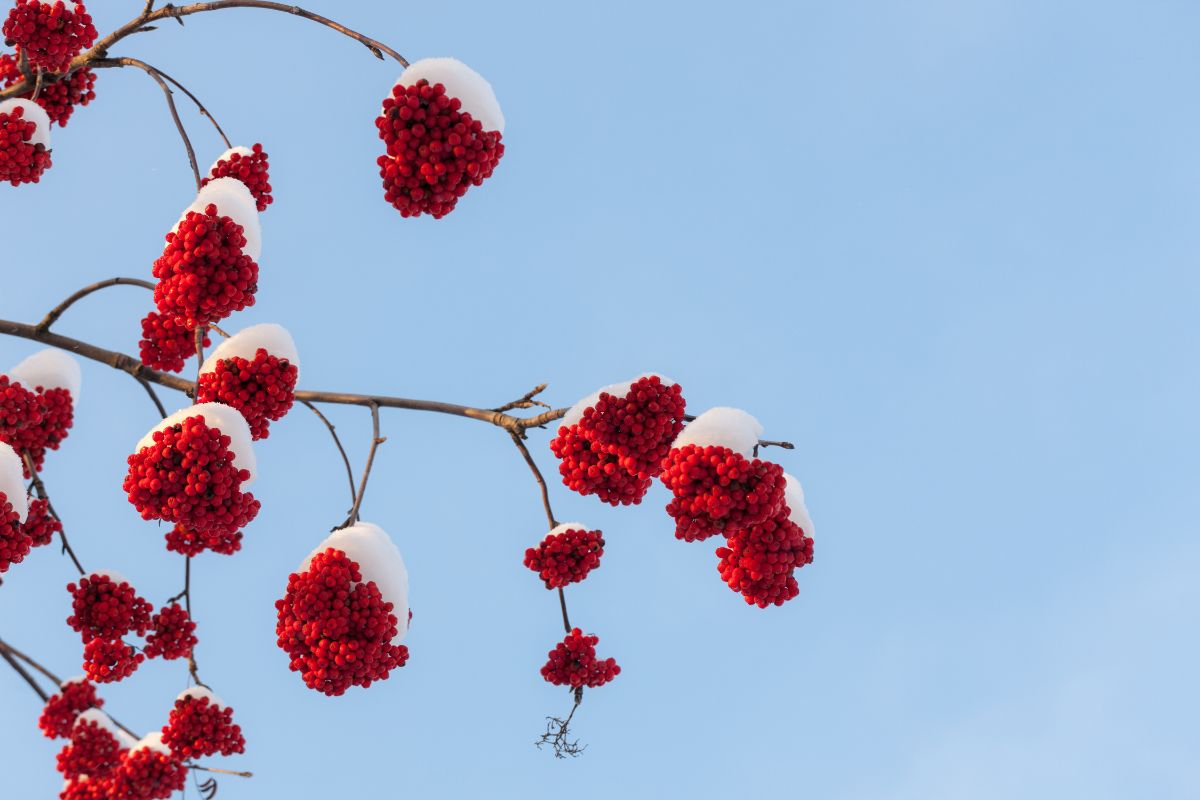
| Plant name: | Rowan |
| Lighting requirements: | Full sun to part shade |
| Watering requirements: | High |
| Growing zone: | Zones 3 to 5 |
| Special features: | Colorful berries; attracts birds |
A member of the rose family, rowan trees are found throughout much of the northern hemisphere. Fern-like, feathery leaves catch the breeze beautifully, but rowans are particularly known for their clusters of bright red berries which birds love. Berries are also edible for humans, but have a slightly bitter flavor, so try them out in sweetened jams and marmalades.
When fully mature, rowan trees max out at around 30’ high. Easy going plants, rowans can adapt to a range of growing conditions, including full sun to part shade.
6. Snowdrops (Galanthus nivalis)

| Plant name: | Snowdrops |
| Lighting requirements: | Full sun to part shade |
| Watering requirements: | Moderate to low |
| Growing zone: | Zones 3 to 8 |
| Special features: | Early blooms; important pollinator plant |
Snowdrops are some of the earliest blooming flowers in late winter to early spring, emerging sometimes even through drifts of snow! Small, bell-shaped white flowers appear on the ends of slender drooping stems, giving the plant a delicate, airy appearance. These flowers are particularly striking planted together in drifts or interplanted in grass lawns for that perfect pop of color.
Growing from bulbs, snowdrops should be planted in autumn before the ground freezes solid. Over time, expect your snowdrops to grow and multiply for an even more fantastic display.
7. Winter aconite (Eranthis hyemalis)

| Plant name: | Winter aconite |
| Lighting requirements: | Full sun to part shade |
| Watering requirements: | Moderate |
| Growing zone: | Zones 4 to 7 |
| Special features: | Early blooms; important pollinator plant |
A lesser known flowering bulb, winter aconite should be planted in autumn for late winter to spring time blooms. Lacey leaves frame yellow, buttercup-like flowers, which are an important food source for early pollinators.
If you have deer in your yard, winter aconite is a good choice as it’s naturally resistant to most pests. For lots of winter color and playful textures, try planting winter aconite alongside snowdrops. It’s always a treat to see these first flowers appear, even through snow!
8. Japanese pieris (Pieris japonica)
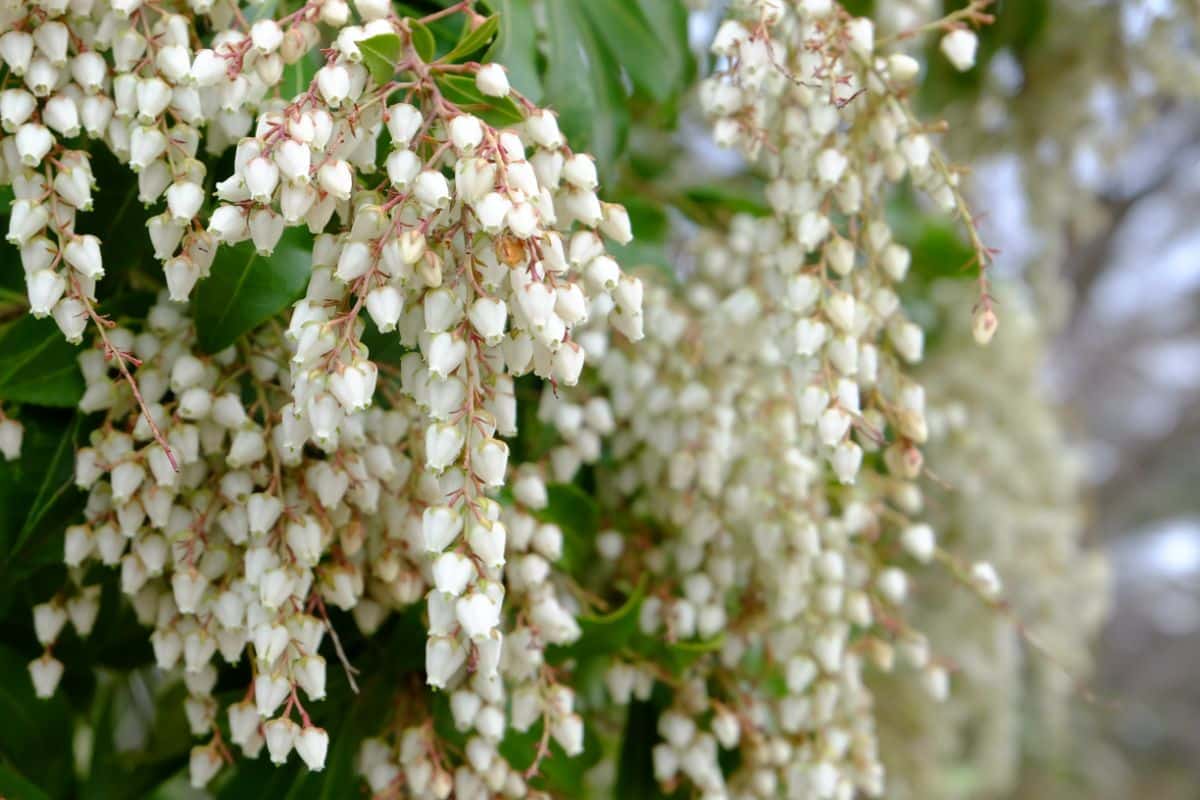
| Plant name: | Japanese pieris |
| Lighting requirements: | Full sun to part shade |
| Watering requirements: | Moderate |
| Growing zone: | Zones 5 to 9 |
| Special features: | Early blooms |
A broadleaf evergreen, Japanese pieris has glossy, lance-shaped leaves that keep their color all winter long. Cascades of small, bell-shaped flowers in pinks and white appear in mid-winter and are long lasting. A relative of heaths, Japanese pieris provides that perfect garden pick-me-up to counter the winter blues.
Growing between 9 to 12’ high, Japanese pieris isn’t just a pretty shrub, it’s also hardy too. This plant is able to adapt to a range of conditions, including shade or sun, but it does prefer moist, well-draining soil.
9. Ornamental brassicas (Brassica oleracea)
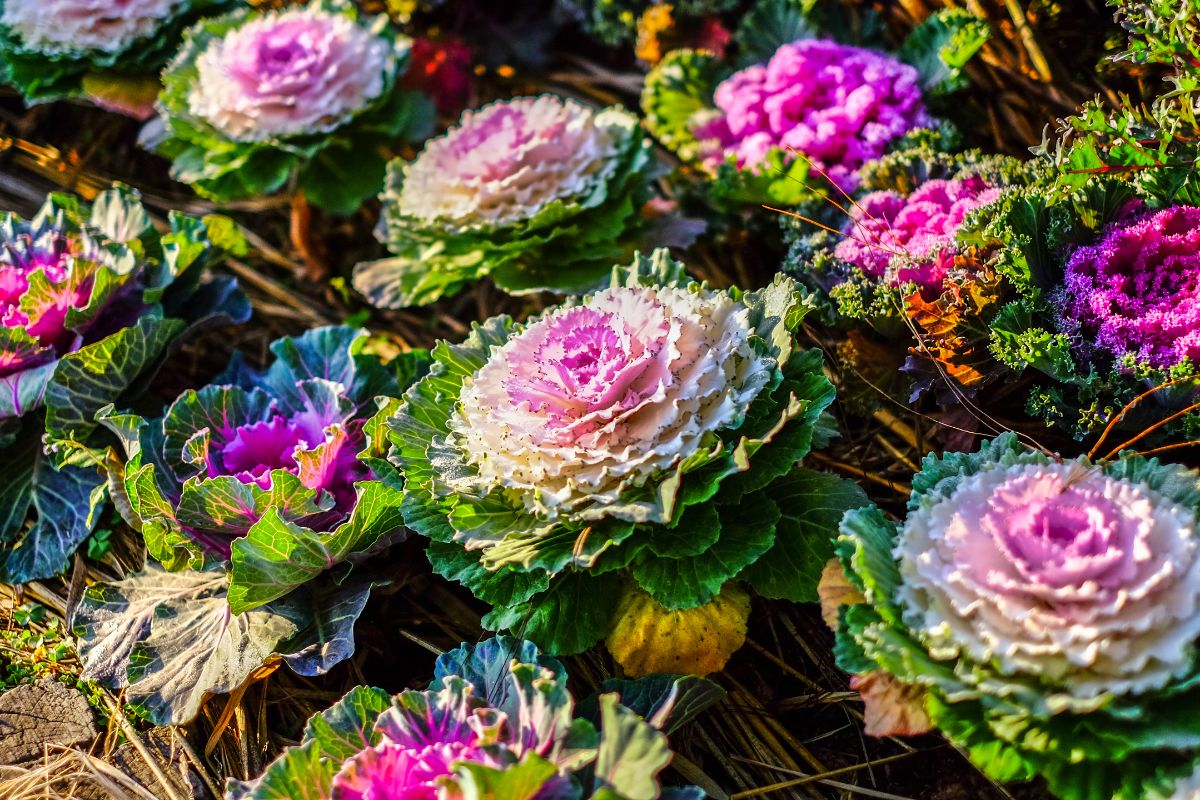
| Plant name: | Ornamental brassicas |
| Lighting requirements: | Full sun to part shade |
| Watering requirements: | Moderate |
| Growing zone: | Zones 2 to 11 |
| Special features: | Colorful leaves; great for container planting |
Ornamental kale and cabbages are common sights in fall planters, but they work in winter gardens too. Brightly colored, frilly leaves come in a range of hues; however, plants with pale yellow or purple coloration are some of the most impressive.
Ornamental brassicas are the same species as edible kale and cabbages (Brassica oleracera); however, they have been selected for their coloration rather than flavor. While they are edible, they often taste a bit bitter, so they are more commonly used as garnishes in recipes.
10. Witch hazel (Hamamelis virginiana)
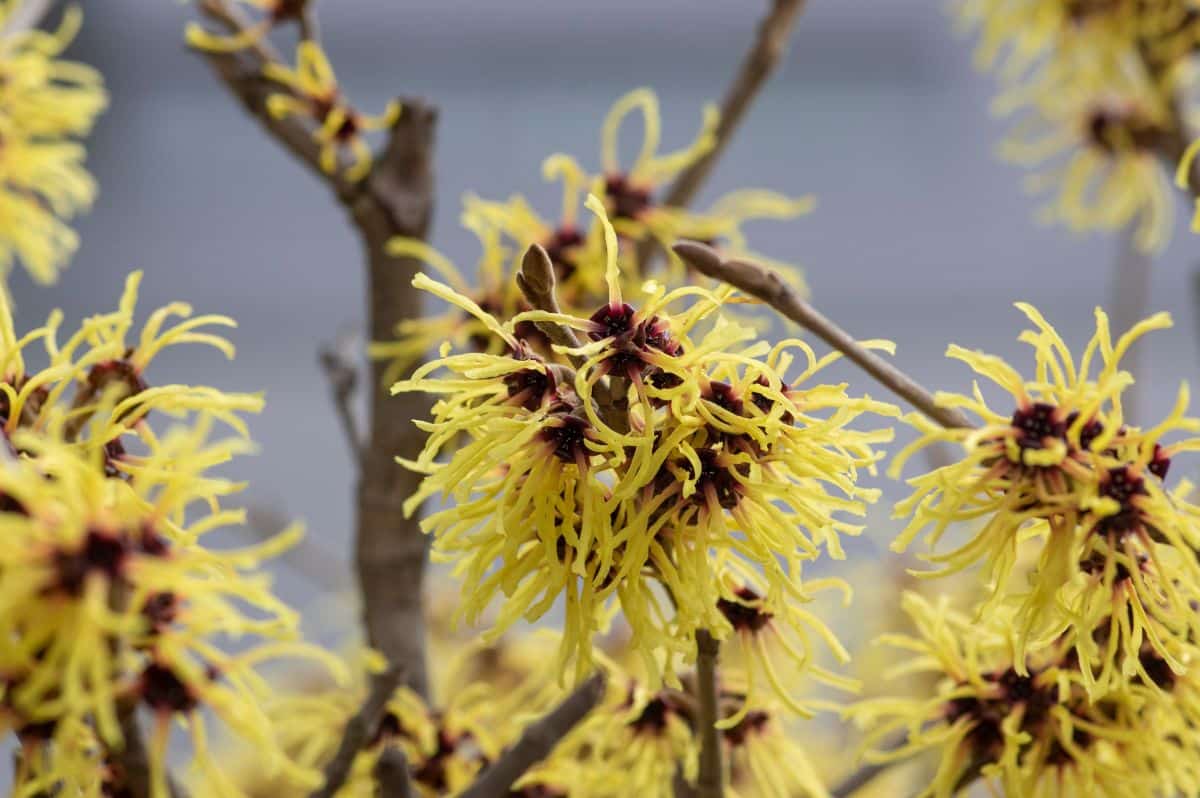
| Plant name: | Witch hazel |
| Lighting requirements: | Full sun |
| Watering requirements: | Moderate |
| Growing zone: | Zones 3 to 9 |
| Special features: | Early blooms |
Witch hazel is a traditional medicinal plant used for its skin-soothing abilities. But it’s a pretty ornamental species too – particularly in winter gardens.
Wispy, yellow flowers blossom in mid-winter and look a bit like tiny fireworks when silhouetted against a snowy garden backdrop. These flowers contrast nicely against the plant’s dark branches for lots of visual interest.
Growing up to 30’ high, witch hazels can be kept smaller with regular pruning. These plants are native to North America, so they’re cold hardy too. Just keep in mind that there are several different species of witch hazel, so make sure you select a cultivar that blooms in winter.
11. Cyclamen (Cyclamen persicum)

| Plant name: | Cyclamen |
| Lighting requirements: | Bright, indirect sun |
| Watering requirements: | Moderate |
| Growing zone: | Zones 5 to 9 |
| Special features: | Early blooms |
A popular houseplant, cyclamens also make a lovely addition to garden beds. Brightly colored flowers bloom in winter to spring with showy petals coming in a range of colors including pinks, reds, white and two-toned varieties. Leaves are often highly patterned too.
Native to Europe and the Middle East, cyclamen are adaptable little plants. To keep them happiest, try locating them beneath deciduous trees in your garden. When the trees drop their leaves in winter, your cyclamen will get plenty of winter sun but in summer your plants will be protected from bright light.
12. Japanese barberry (Berberis thunbergia)

| Plant name: | Japanese barberry |
| Lighting requirements: | Full sun to part shade |
| Watering requirements: | Low |
| Growing zone: | Zones 4 to 8 |
| Special features: | Colorful berries; attracts birds |
A common ornamental shrub, Japanese barberry bushes feature thick, thorny branches and red, oval-shaped berries that remain on the bush all through winter. Great for attracting birds, Japanese barberry’s dense growth pattern makes them a good choice for privacy during winter months too.
Growing about 6’ tall by 7’ wide, try planting barberry bushes around the perimeter of your yard to provide extra shelter for wild birds.
13. Cotoneaster (Cotoneaster apiculatus)
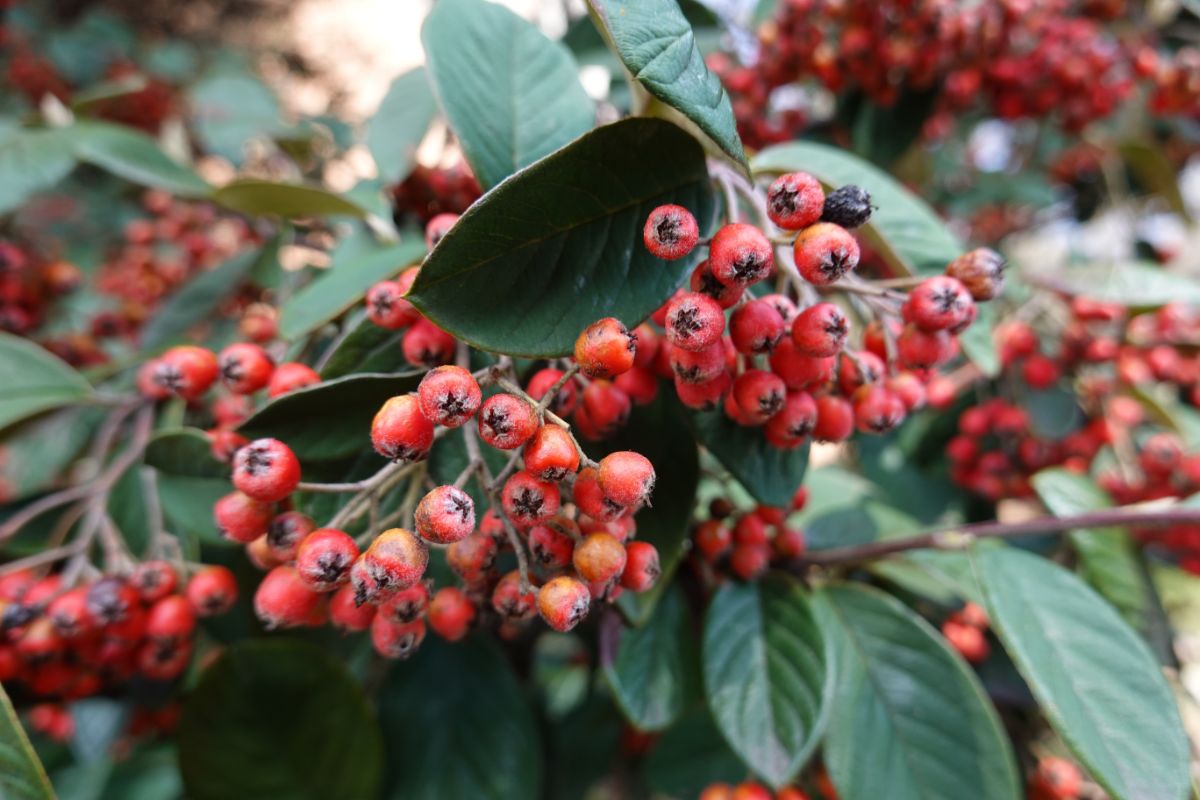
| Plant name: | Cotoneaster |
| Lighting requirements: | Full sun to part shade |
| Watering requirements: | Low |
| Growing zone: | Zones 5 to 8, depending on variety |
| Special features: | Colorful berries; attracts birds |
Related to hawthorns and rowans, cotoneasters are another ornamental shrub that boasts bright, red berries in wintertime. Once mature, these plants max out at about 7’ high with slender canes that grow quite rapidly, particularly as the plant ages.
A good food source for birds, cotoneasters are a fun addition to holiday displays as well!
14. Beautyberry (Callicarpa americana)
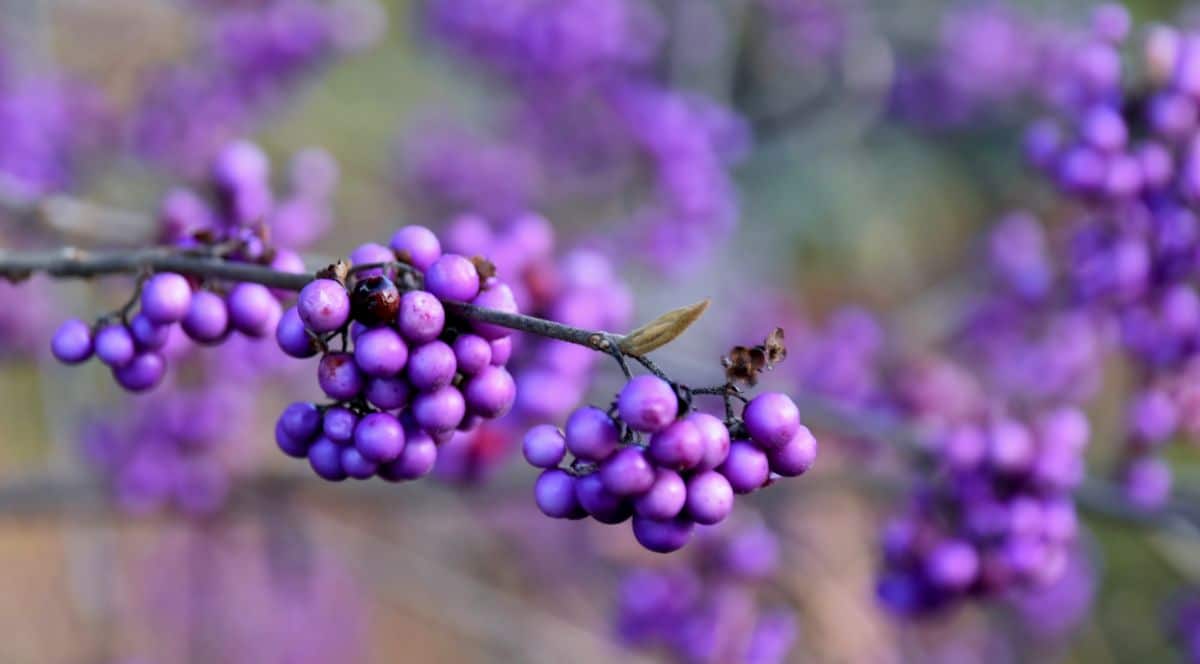
| Plant name: | Beautyberry |
| Lighting requirements: | Full sun to part shade |
| Watering requirements: | Moderate |
| Growing zone: | Zones 5 to 10, depending on variety |
| Special features: | Colorful berries; attracts birds |
While there are a number of shrubs that bear berries in wintertime, most of those plants offer red fruit. But not beautyberry.
This distinctive ornamental features clusters of bright pinkish-purple berries for a very unique garden look. A favorite food source for quail and deer, beautyberry usually reaches about 5’ in height, but it can grow up to 10’ tall in ideal conditions. Beyond the namesake beautiful berries, this gorgeous shrubs provides fine lines and a graceful, arching form in the garden.
15. Rose (Rosa rugosa)
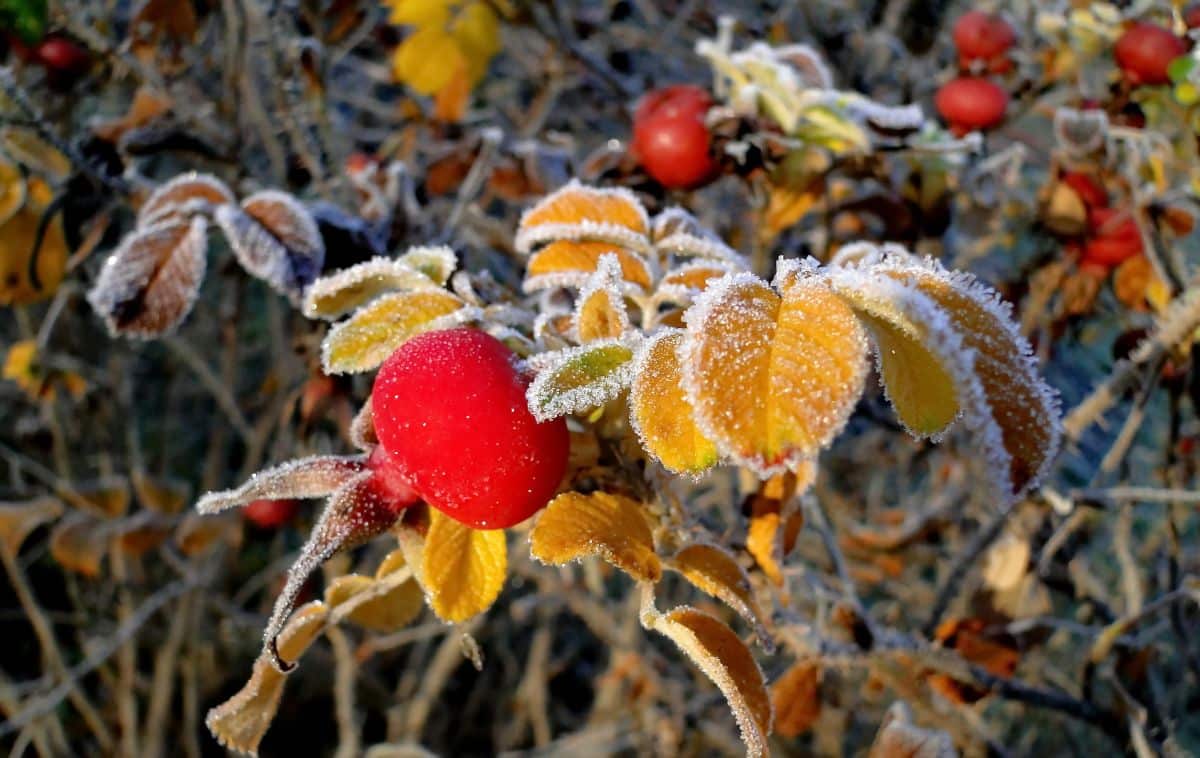
| Plant name: | Rose |
| Lighting requirements: | Full sun |
| Watering requirements: | Moderate |
| Growing zone: | Zones 3 to 9 |
| Special features: | Colorful and edible fruit; attracts birds |
Roses are most commonly kept for their bright, beautiful blooms, which last from spring to fall. However, after those roses fade, many rose varieties produce large, red fruit, or rose hips. In the winter garden, rose hips provide a nice bit of color and a valuable food source for birds and other wild creatures.
Rose hips are edible and packed with vitamin C and other antioxidants and make a tasty tea or jam. While all rose varieties produce edible rose hips, hips from Rosa rugosa are quite large and said to be some of the tastiest.
16. Winter heath (Erica carnea)

| Plant name: | Winter heath |
| Lighting requirements: | Full sun to part shade |
| Watering requirements: | Low; plants need more frequent watering during first year |
| Growing zone: | Zones 5 to 7 |
| Special features: | Early blooms |
Winter heath is a low growing perennial shrub that grows in rounded clumps to about 12” in height. Needle-like leaves keep their color all year round, but winter heath produces sweet little, urn-shaped blooms in winter that are pinkish-purple in color. These delicate flowers have papery petals that make a tinkling sound when ruffled about in the breeze.
Not all heaths bloom in winter, so when choosing your plants, make certain you pick a cultivar that does. Also, heaths are often confused with heathers; however, heathers have scale-like leaves and are more winter hardy.
17. Pansies and violas (Viola spp.)

| Plant name: | Pansies and violas |
| Lighting requirements: | Full sun to part shade |
| Watering requirements: | Moderate |
| Growing zone: | Zones 7 to 10; grown as an annual in cooler locations |
| Special features: | Year long blooms in warm climates; long-bloom time in cool climates |
Ever popular pansies and violas are versatile plants. Despite their delicate appearance, they are quite cold hardy and can tolerate some light frosts, so they are a perfect pick for spring garden beds. But that cold hardiness also makes them a great plant to add color to winter gardens too.
In warmer climates, pansies and violas can bloom all year long, even in winter. However, in colder spots they grow as annuals and will be killed by hard freezes. The good news is these easy-going plants self-seed rapidly so they’ll often spring up year after year, whether you plant them or not.
18. Harry Lauder’s walking stick (Corylus avellana)
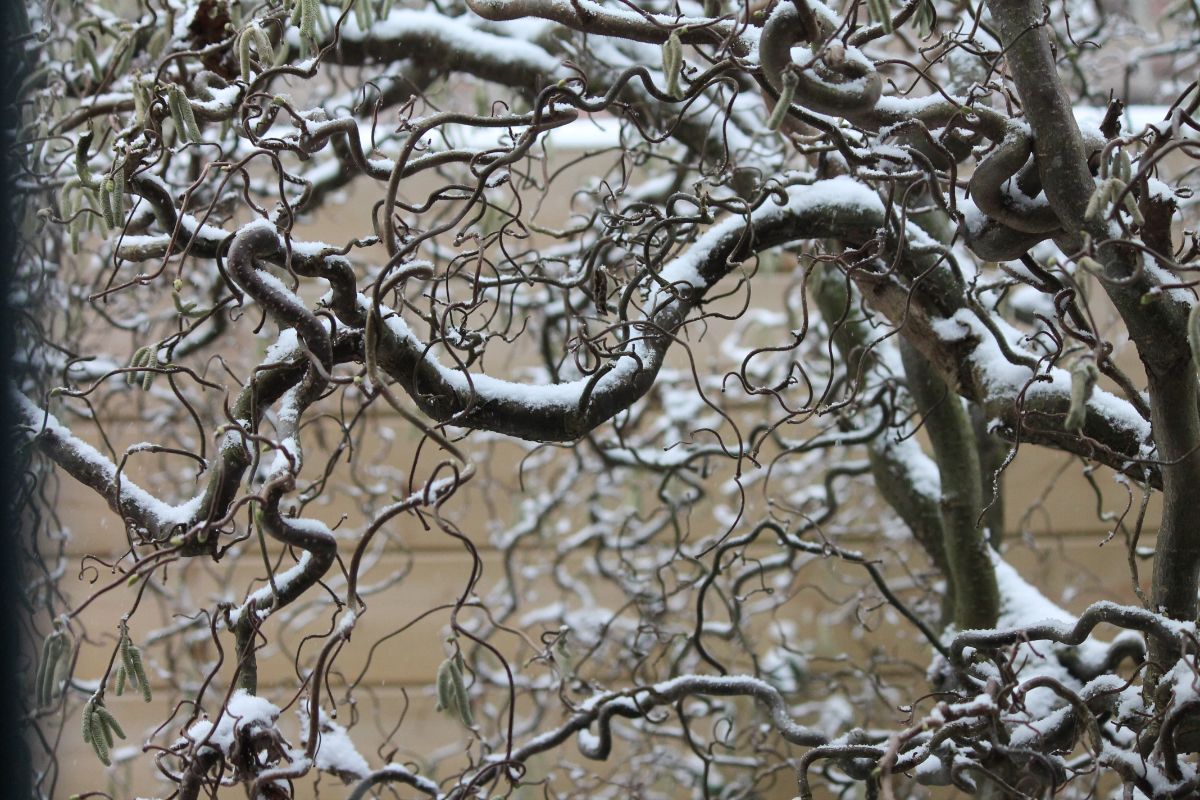
| Plant name: | Harry Lauder’s walking stick |
| Lighting requirements: | Full sun to part shade |
| Watering requirements: | Moderate |
| Growing zone: | Zones 4 to 8 |
| Special features: | Curling, textural branches |
Also known as the corkscrew hazel, Harry Lauder’s walking stick is a unique choice. This deciduous shrub grows to about 10’ tall and produces yellow catkins in winter and early spring to liven up your landscape.
But the true beauty of the corkscrew hazel is its distinct and gnarled branches. Branches naturally form corkscrews and spirals, which become readily apparent when leaves drop in autumn. In winter beds, branches draw the eye in and are sure to be a conversation starter with garden visitors.
19. American wintergreen (Gaultheria procumbens)
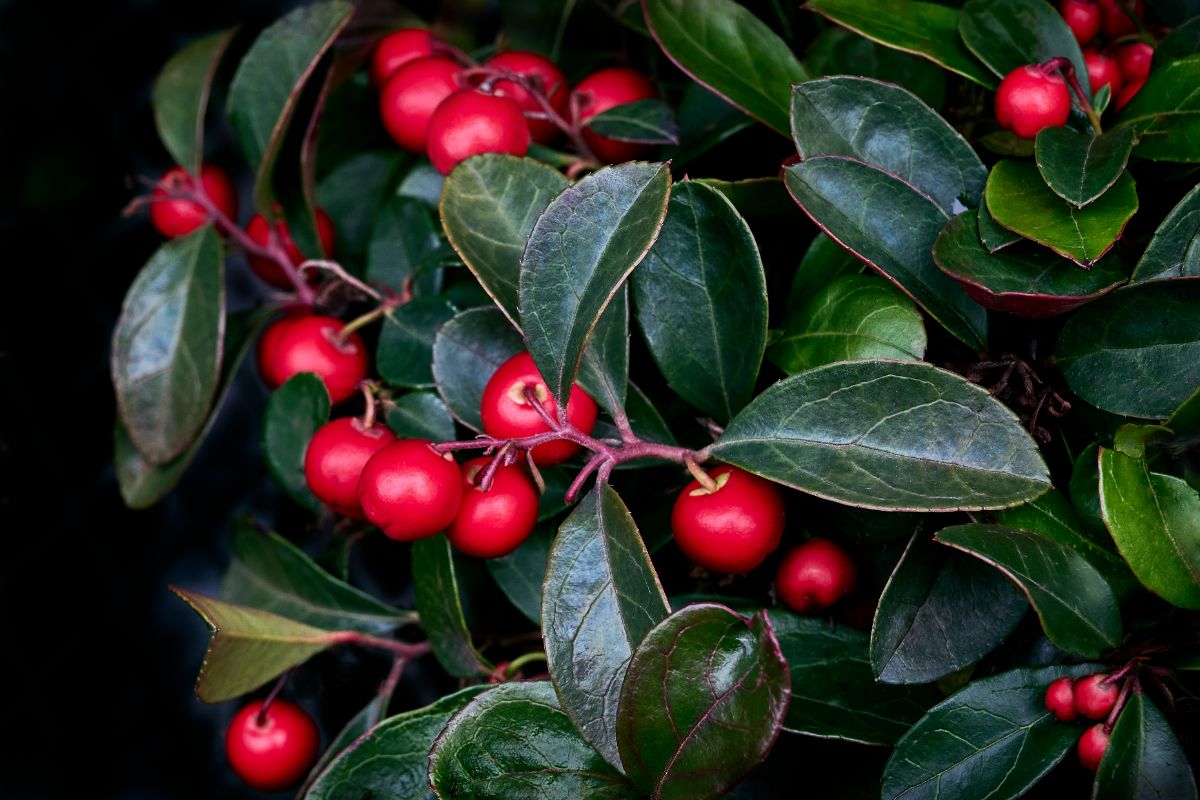
| Plant name: | American wintergreen |
| Lighting requirements: | Full to part shade |
| Watering requirements: | High |
| Growing zone: | Zones 3 to 7 |
| Special features: | Edible plant; colorful berries; attracts birds |
American wintergreen is a low growing, woody evergreen with glossy leaves. Often used as a groundcover, this low maintenance plant tolerates quite a bit of shade, so it’s a good solution in gardens that don’t get a lot of sun.
In winter, wintergreen produces bright red berries that are favored among wildlife and humans alike. In fact, both the berries and leaves of this plant are edible and are often used as a flavoring for desserts like teaberry ice cream. However, this plant does contain components that act like aspirin in the body, so don’t eat too much of it at one time.
20. Hellebores (Helleborus orientalis)
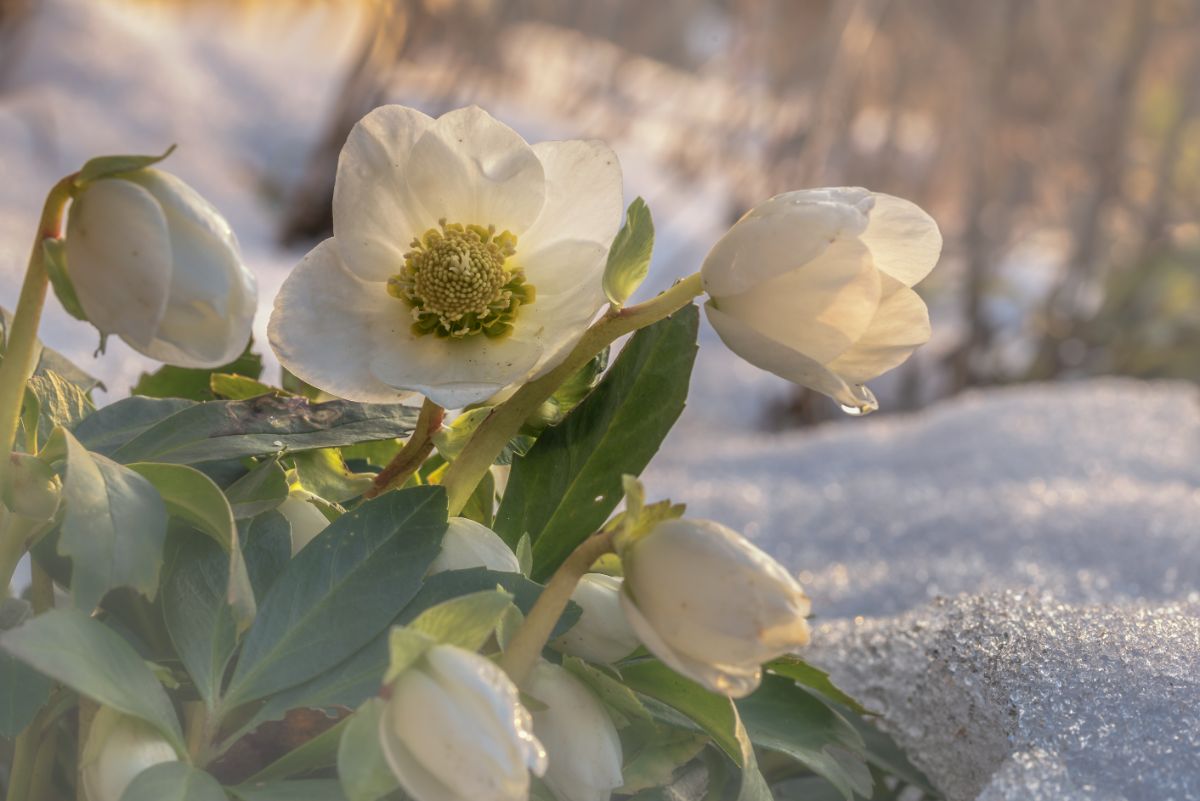
| Plant name: | Hellebores |
| Lighting requirements: | Full sun to part shade |
| Watering requirements: | Moderate |
| Growing zone: | Zones 6 to 9 |
| Special features: | Early blooms |
Another early springtime bloomer, hellebores can even flower in mid- to late winter; however, blooms usually occur around Eastertime. A delicate looking flower, hellebores are surprisingly hardy and can even push their way up through light snow. Hellebores are sometimes referred to as “Lenten roses” due to their bloom time.
Flowers feature rounded petals that look a bit like poppies or wild roses. Petals come in almost every color you can imagine, with dusty rose, dark black or chartreuse varieties making particularly stunning additions in winter garden beds.
21. Ornamental grasses

| Plant name: | Ornamental grasses |
| Lighting requirements: | Depends on variety |
| Watering requirements: | Depends on variety |
| Growing zone: | Depends on variety |
| Special features: | Attracts birds; year-long color |
There’s so many reasons to try out ornamental grasses in your garden. They are relatively low maintenance and grow rapidly, producing seed heads that wild birds love. Growing quite densely, ornamental grasses provide exceptional privacy for backyards too.
In winter, ornamental grasses usually turn golden in color and keep their fine shapes all winter long. When the winter winds start blowing, you’ll also be rewarded with a sweet rustling sound from these specimen plants too.
While there are many different ornamental grasses to try in your winter garden, some of the best choices are pampas grass, zebra grass, Ravenna grass, maiden grass, purple millet and fountain grass.
22. Tibetan cherry (Prunus serrula)
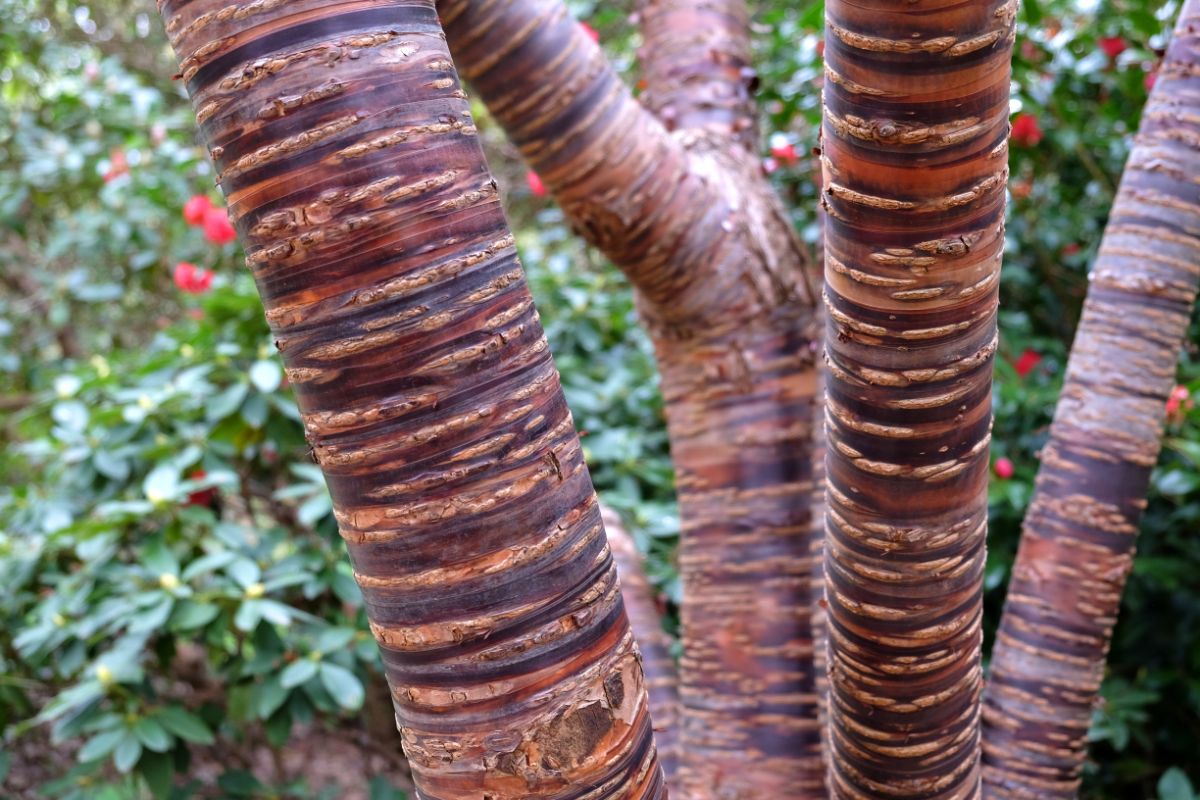
| Plant name: | Tibetan cherry |
| Lighting requirements: | Full sun to part shade |
| Watering requirements: | Moderate |
| Growing zone: | Zones 5 to 6 |
| Special features: | Colorful bark |
Also known as the paperbark cherry, Tibetan cherry trees are native to China. Growing 20 to 30’ tall, these striking trees produce small, white flowers in springtime, but they are excellent plants for winter too.
A popular ornamental tree, Tibetan cherries are known for their vibrantly colored, coppery-red bark. This bark catches the sunlight brilliantly and even takes on a slightly striated appearance, which is sure to contrast nicely against freshly fallen snow.
23. Coral bells (Heuchera americana)
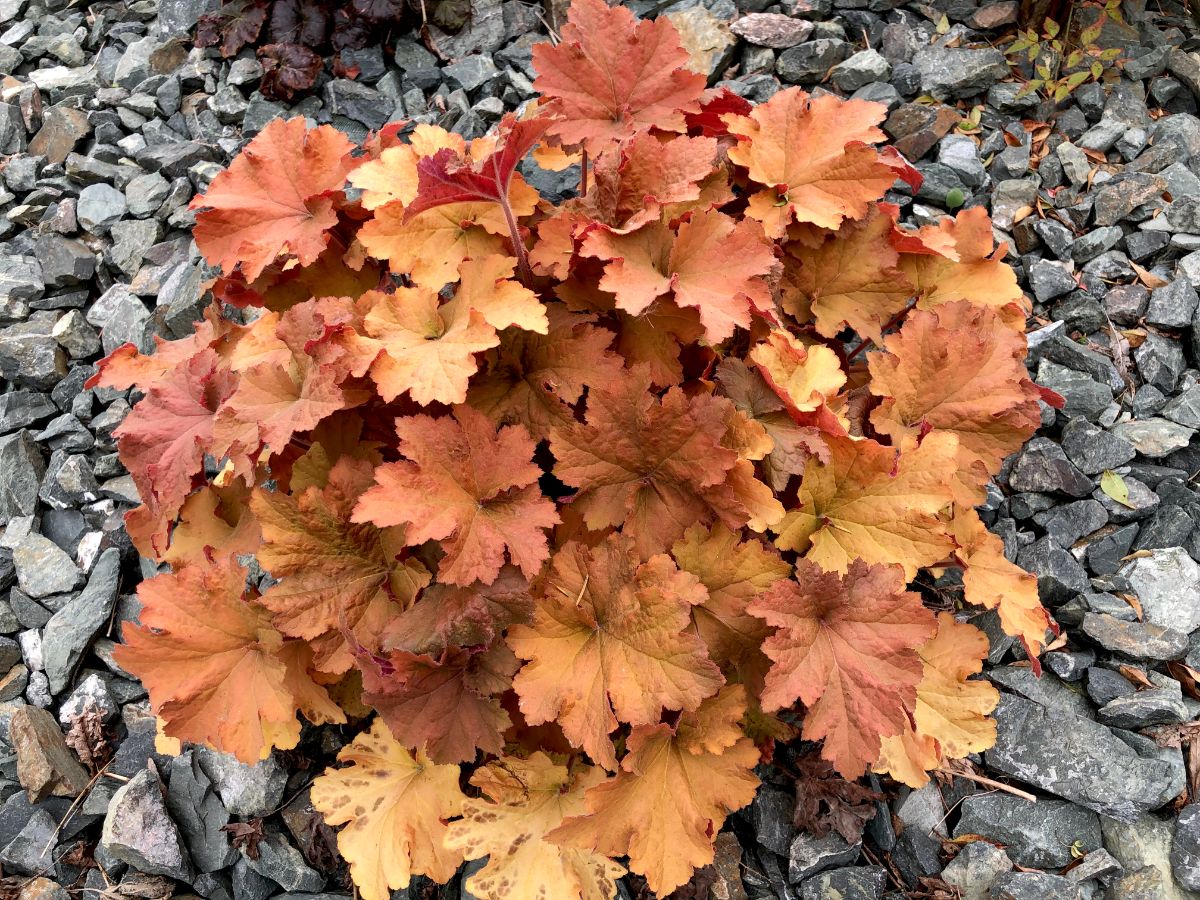
| Plant name: | Coral bells |
| Lighting requirements: | Full sun to part shade |
| Watering requirements: | Moderate |
| Growing zone: | Zones 4 to 9 |
| Special features: | Colorful leaves |
Also known as alumroot, coral bells produce delicate and airy flowers at the ends of long stems during summertime. But most gardeners keep these delightful plants for another reason: their colorful leaves.
Coral bells’ distinct leaves come in many different colors, including vibrant green, dark purple and orange and leaves with marbled coloring. Hardy to zone 4, coral bells are quite resistant to the cold in general. In warmer locations, they will stay colorful all winter long too!
24. Golden willow (Salix alba)
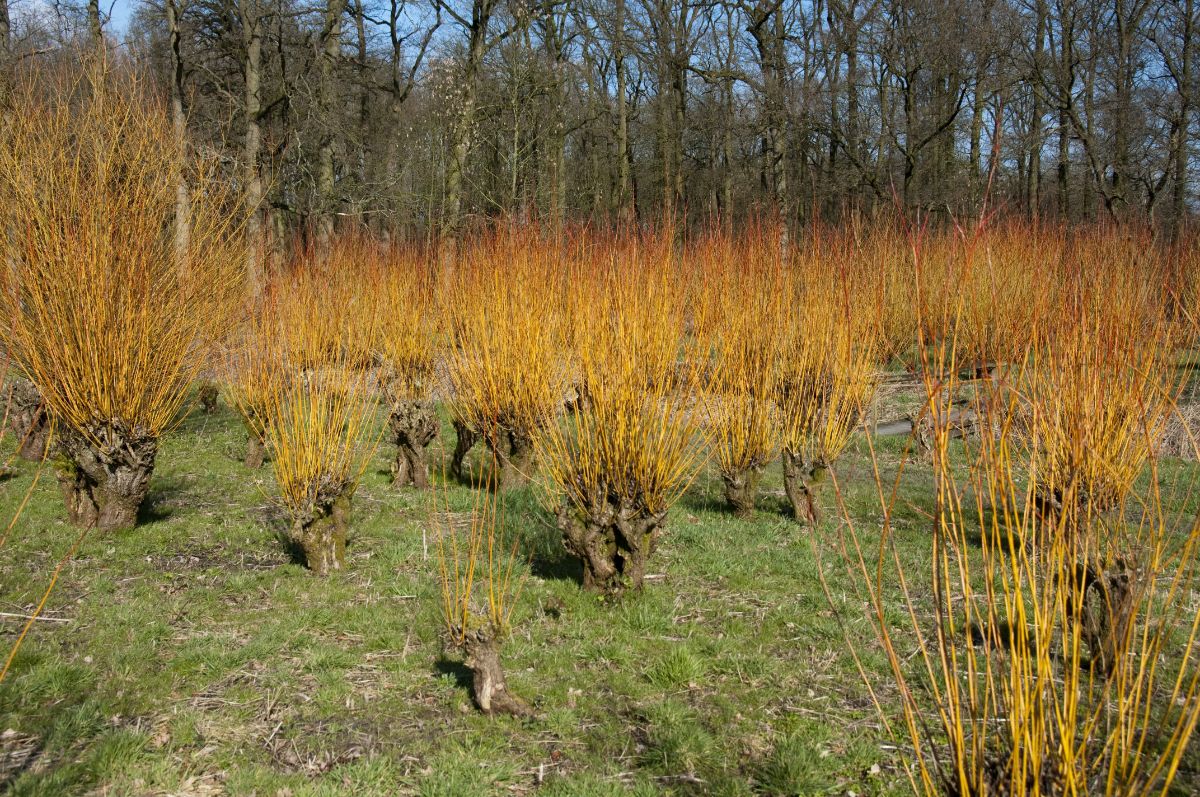
| Plant name: | Golden willow |
| Lighting requirements: | Full sun to part shade |
| Watering requirements: | High to moderate |
| Growing zone: | Zones 2 to 9 |
| Special features: | Colorful branches |
Willows are some of the most popular trees to grow for a number of reasons. They are relatively easy-going plants and their delicate branches are quite feminine in appearance and catch the wind beautifully all year long.
But in winter, golden willows are the cultivar of choice. Growing up to 50’ tall, these plants feature brightly colored yellow to orange branches for lots of garden color. For even more contrast, try planting these trees near other vibrant specimen plants, like red twig dogwood.
Frequently asked questions
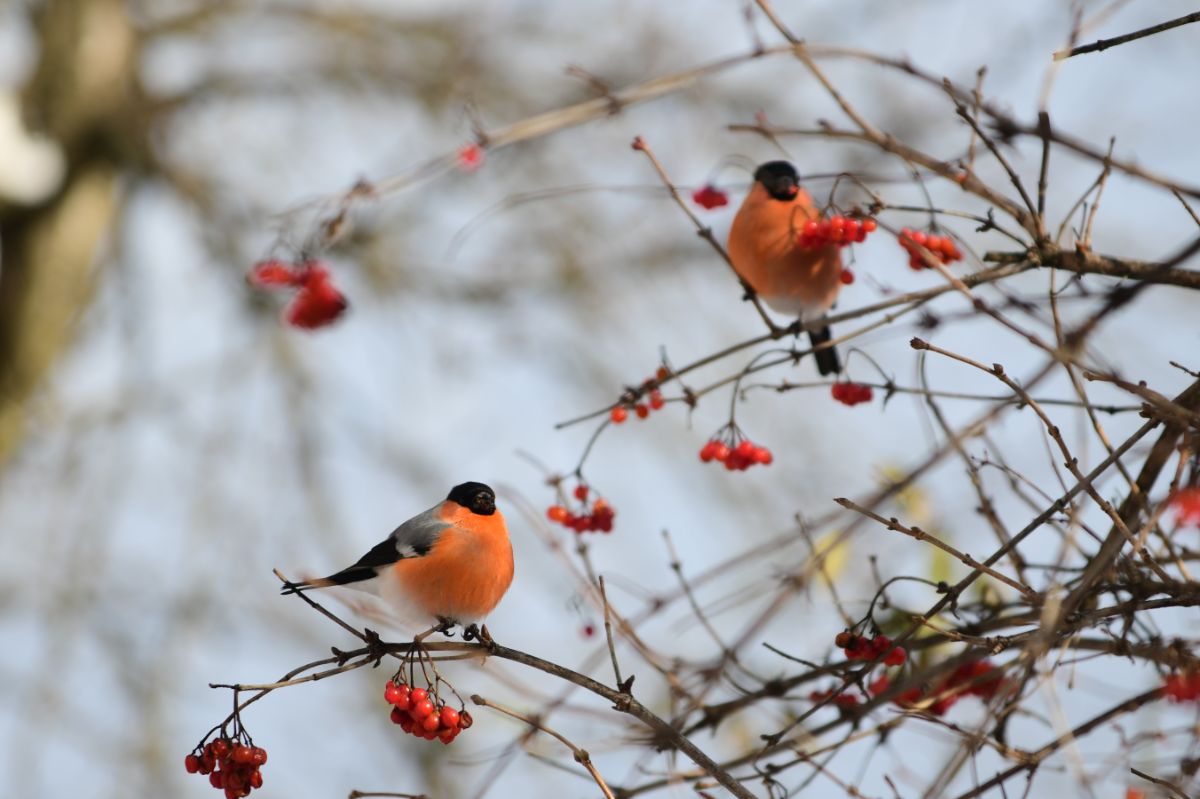
Winter interest plants are the best solution for adding tons of color and texture to winter gardens. Look for plants that flower well into winter, or specimens with other fun elements like sculptural lines or colorful bark.
Winter interest plants are plants that have special features that come alive in winter gardens. Those features can include colorful berries, brightly colored branches, interesting branch formations and early-emerging flowers.
As their name suggests, evergreen shrubs stay green all year round. Some of the best evergreen shrubs that stay green in winter include hollies and heath.
Any plant that keeps its leaves year round is a good solution for maintaining privacy in the garden in winter. Thanks to their dense growth habit, ornamental grasses are a popular choice, but any evergreen bush will do well too.
Summary
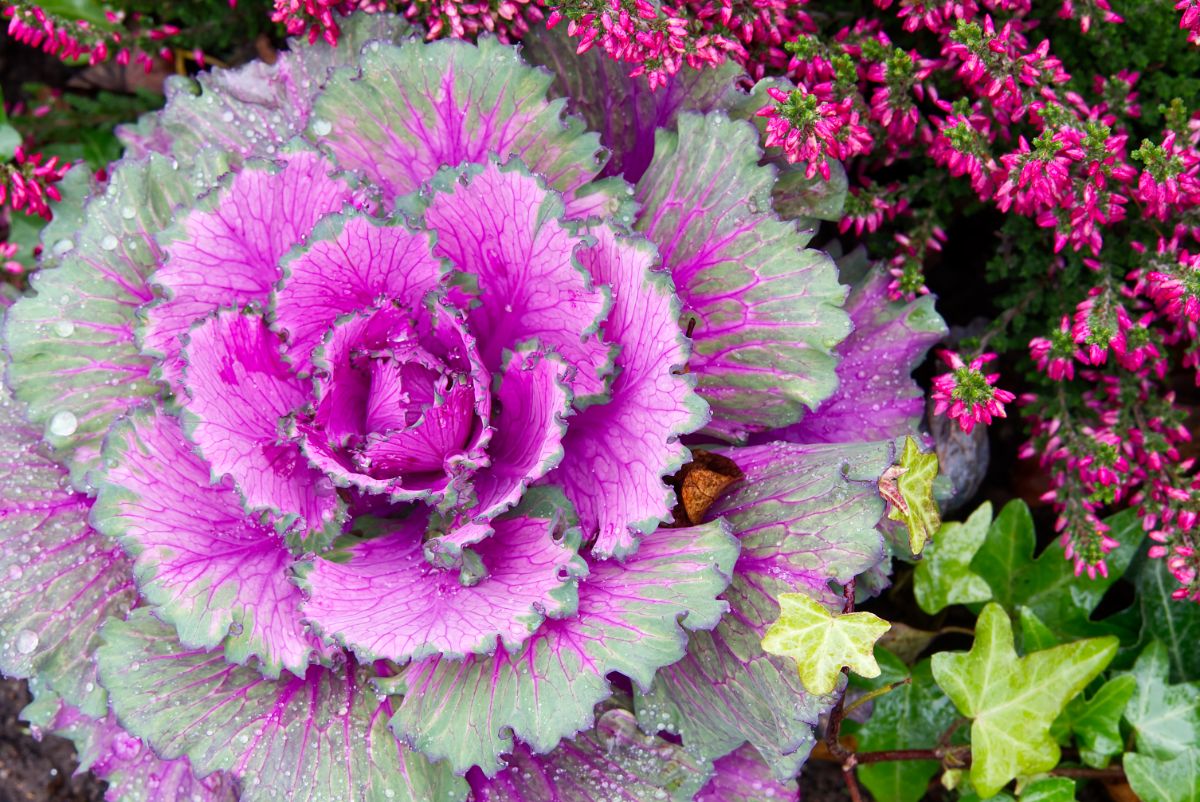
After flowers fade and leaves fall in autumn, many gardens can look a bit lackluster until spring. But adding winter interest plants can spice up drab winter beds and add that much-needed pop of color to counteract the winter blues.
From winter-blooming bulbs to large specimen trees, there are lots of different plants to choose from for the winter garden. A carefully curated winter bed can be just as colorful in winter as in spring and will look even prettier when dappled with fresh snow.
If you liked this article, check out our piece on growing winter-blooming hellebores.

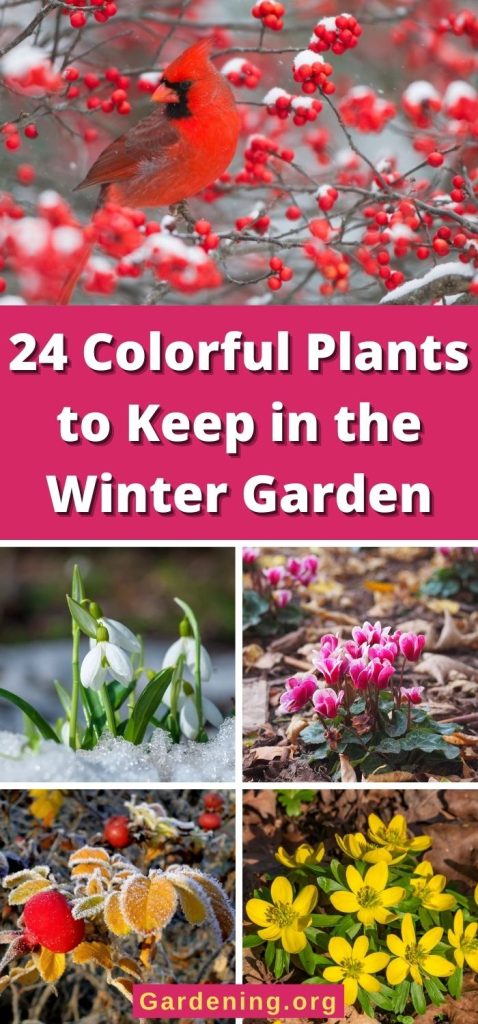
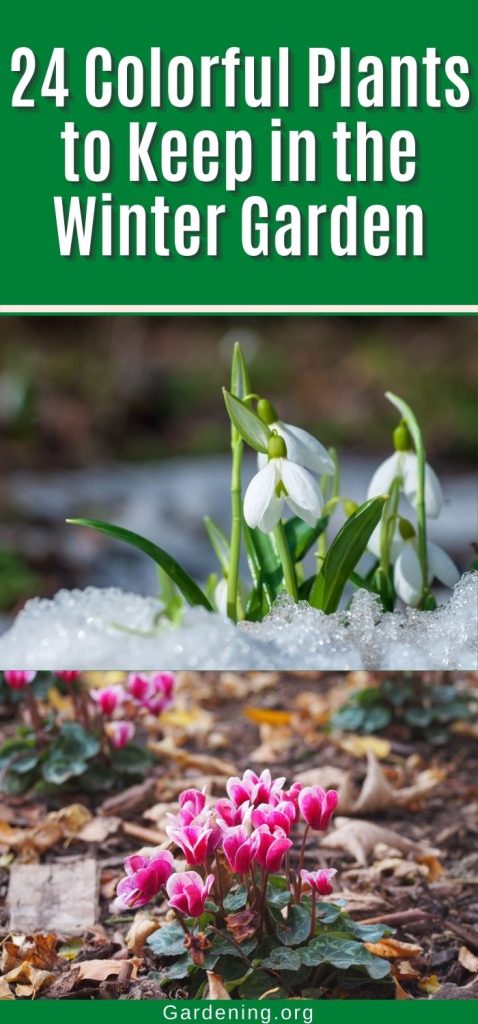
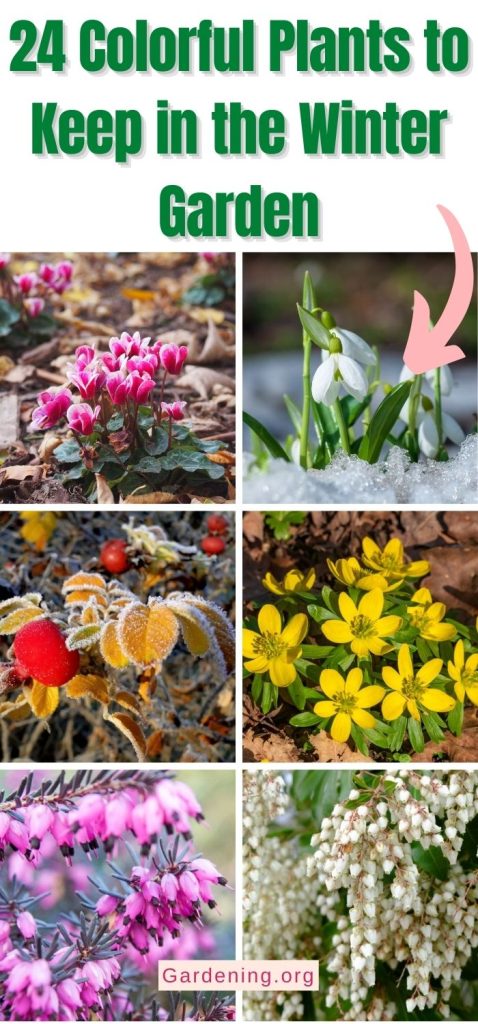


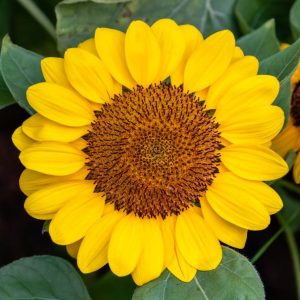
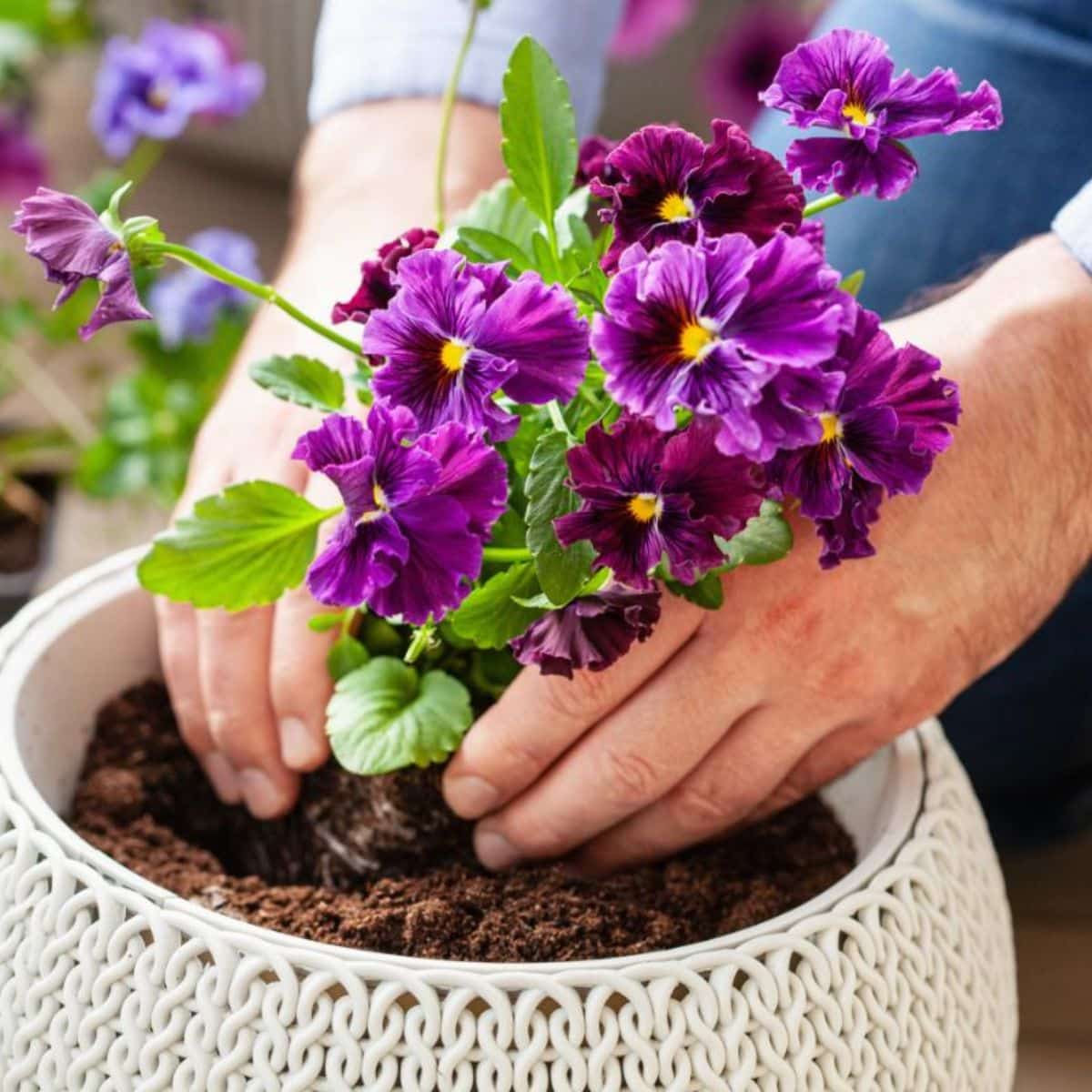
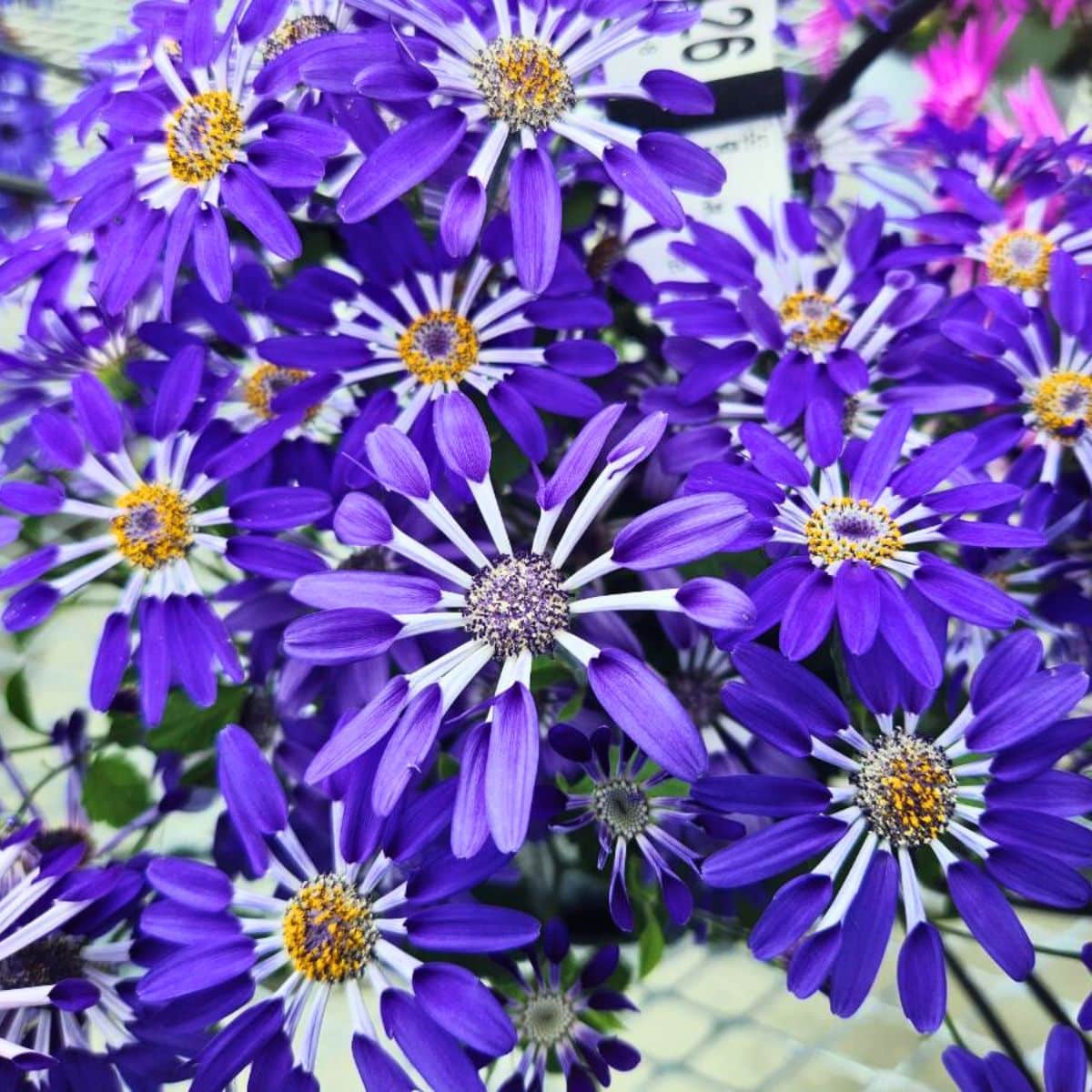
Leave a Reply